A Story of Scribal Collaboration: the Targum of T-S 6H5.11
Introduction
The Genizah is a primary place to find stories of everyday medieval Jewish life embedded in texts, and many times these accounts are spelled out loudly on the page in dusty, aging letters. But rediscovery is even more satisfying when a fragment whispers indirectly, telling a clear, almost personal story through every aspect of its physicality and textuality. This month’s featured fragment, T-S 6H5.1, is a manuscript that requires you to listen closely in order to fully encounter it.
Preserved in 14 unassuming paper pages, the manuscript contains the Targum texts of the five haftarot before Pesach, with headings for each new passage and Hebrew lemmata scattered inconsistently throughout. Written in two distinctive hands, it instantly catches the eye, and its passage organisation and liturgical headings have not gone unnoticed by scholars.2 However, this scrappy manuscript has far more to reveal than simply a mundane, practical assortment of passages, even though its writers intended it to be just that.
The Identities of the Scribes: Master and Apprentice?
Immediately upon seeing the manuscript, one meets the work of two people. Klein noted this in his catalogue, where he describes the script as an ‘Oriental script; interspersed passages in square and untrained linear square (scribe and child?).’ Indeed, some pages have both hands, while others were only written by one hand, and thus risk being mistaken as part of a separate document; it is remarkable that we have so many pages preserved together.
The first hand to greet us is that which Klein proposed as possibly being written by a child. While we cannot know the (unstated) age of this scribe, it is clear why Klein raised the possibility. The letters are irregularly sized and written at awkward angles to each other, and the text is arranged in crooked lines (to the scribe’s credit, the page isn’t ruled), with numerous smudges and corrections. The greatest oddity is the sof pasuq sign: two circles often drawn instead of dotted, which can appear anywhere: mid-line, end of line, or confusingly, at the very beginning of a line (see fol. 2v, line 5). Eventually, this scribe gets tired, and this is very obvious as the writing gets sloppier. He apparently took a break on folio 3v, before coming back to write the next passage in a smaller, more controlled manner (and he even had the energy to add in vowels).
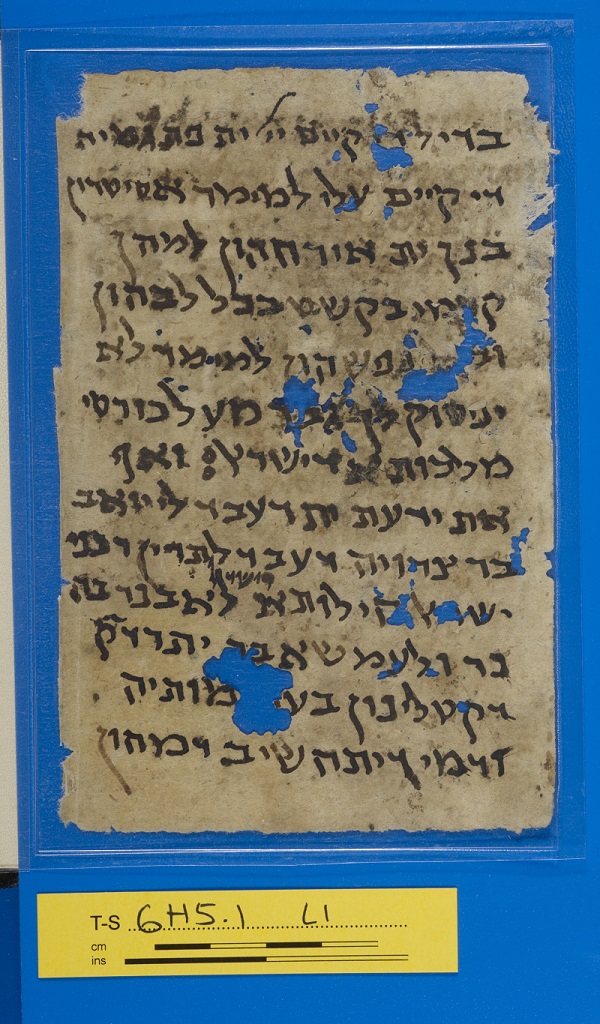
The less skilled hand of our manuscript T-S 6H5.1 Leaf 1 verso. Notice the correction of דישראל in a calligraphic hand above line 10.
One may notice that I call him a ‘scribe’, and that is intentional: though the writing is not the most beautiful, it is the product of training. Take for example fol. 3 (both sides). A careful look shows that the entire page is written by the same person (note the distinct bottom curve in the middle stroke of the alef; the consistent curved angles of dalet and resh; the tetragrammaton is distinctive throughout the manuscript; the curves of the long soffit letters stay the same). Such features are only present in the script of one who has been trained to write them, even if they are at times clumsy and irregular.
The second hand we encounter is distinctive. It is intricately calligraphic, with many downward pointing serifs and small, delicate curves and points. The writing is highly regular, with impressively straight lines, consistent sizing, and tastefully proportioned vowel signs. Unlike the other hand, it is spaced intentionally, with a small sof pasuq that never appears at the beginning of a line, and lemmas which are set apart from the main text by spacing. Such writing was described by Klein as that of a scribe, which is doubtlessly accurate. Both of these hands interplay across the pages, and as we shall see below, their collaboration may suggest that the more trained scribe was perhaps overseeing the less trained one, helping him produce more consistent and aesthetic work.
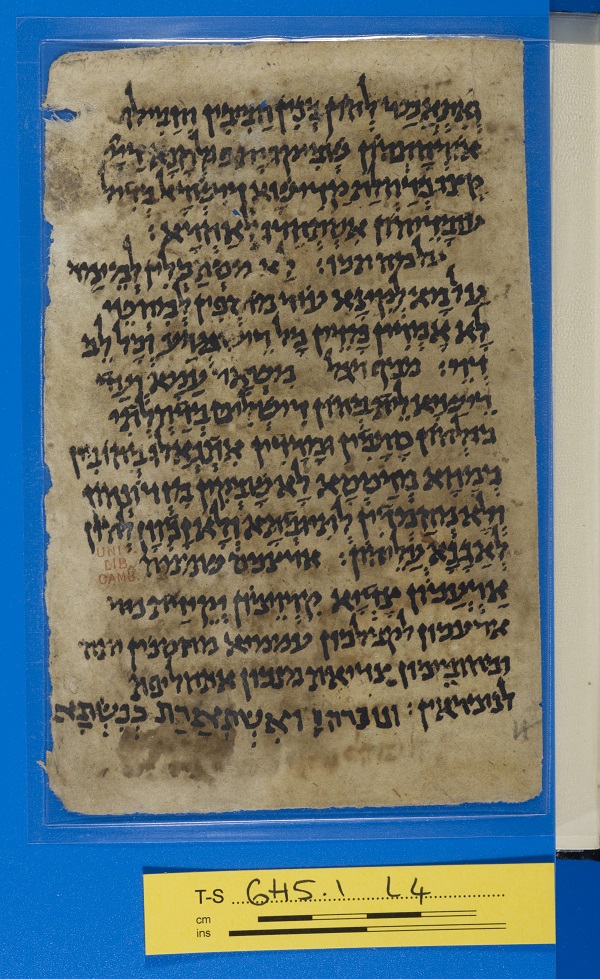
The calligraphic hand of our manuscript T-S 6H5.1 leaf 4 recto
The Anatomy of Collaboration: A Practical Piece of Work
As mentioned above, the hands of both writers appear together at multiple points across the pages. But a closer look reveals a significant degree of collaboration between both scribes. The majority of the text is written by the first, less sophisticated hand. He writes all of fol. 1, 2, and 3 (Deut. 31.16, 1 Kgs. 2.1–12, Deut. 32:1–3, Isaiah 1.2–4). Mid-verse on fol. 4r. the sophisticated scribe picks up, writing the rest of Isaiah 1:4–7. On the same page the ‘apprentice’ begins again with Isaiah 1:8, continuing for two more pages (Isa. 1:8–9; 18–19; Deut. 33:1–2, Josh. 1:2, Josh 1:3–6. On fol. 6r the sophisticated scribe appears again for a short passage: Josh. 1:7–9, but then lets the apprentice take over for fols. 6v–8r (Exod. 30:11–16, Hos. 2:1–7; 21–22). The Torah passage discussing Amalek is introduced by the highly-trained scribe (Deut. 25:17–14) on fol. 8v, with the phrase introducing the haftarah (כה אמר ייי), which he kindly writes for his apprentice. The apprentice then writes the haftarah from fol. 8v–9v (1 Sam. 15:2–9; 31). After ending the haftarah with a note in Arabic, the apprentice lets his master take over on fol. 10r. (Num. 19:1–3). Oddly, this passage now includes the Hebrew alongside the Aramaic, where before there were only Hebrew lemmata. In the last continuous passage the apprentice writs for fols. 10v–11v (Ezek. 36:25–31; 37:14.)
At this point the text becomes a confusing mix of hands. Master and apprentice alternate in short succession for fols 12.r–13r (Ex. 12:1–9, Isa. 41:27–28, Isa. 41:28–29, Isa. 42:1–2. Isa. 42:3–10). What was the purpose of such alternating? Was it to teach? This is unclear, but it does not continue: the manuscript ends in the hand of our apprentice, from fols. 13v–14v. (Exod. 11:1–3, this time with the whole Hebrew verse, Hag. 2:6–9). The text leaves off abruptly, and presumably such interplay of the two hands continued on in leaves now lost to us. One will note that these passages concur with the Palestinian triennial reading schedule of the parashiyyot and haftarot.3
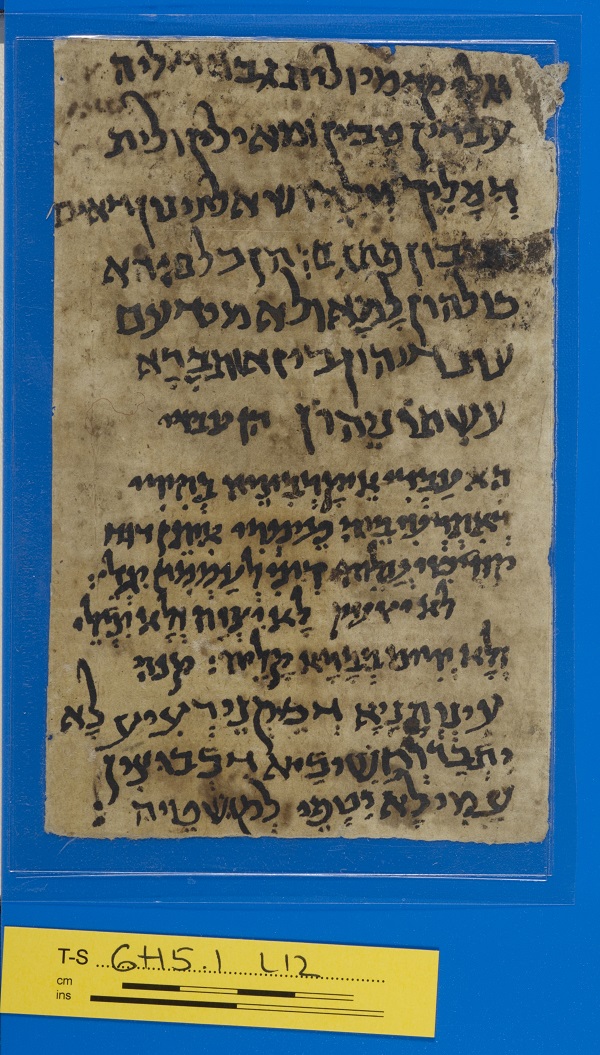
Both scribes working together on one page (T-S 6H5.1 leaf 12 verso)
Besides the tight alternation and interruption of verses between hands, once the more highly-trained scribe corrects the other (fol. 1v, line 10, where he inserts the missing דישראל in the middle of 1 Kgs. 2:5). A possible colophon appears in the first two lines of the last page, but it is poorly scrawled and inked out, with only מנחם ל[] אב הבנים legible. Klein writes in his catalogue that this says אם הבנים, but a microscopic look at the word seems to indicate it is a bet and not a mem soffit. The colophon’s handwriting is that of the less-skilled scribe – if it is his name, then he was not a child!

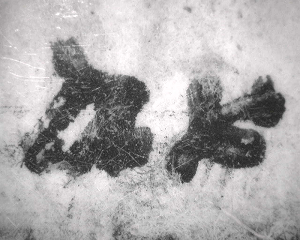
A possible colophon (T-S 6H5.1 leaf 14 verso) and detail from infrared microscope image
The story told is that of these two scribes working together (although the less skilled one much more than the other; perhaps he needed the practice?) to create a record of the haftarah passages for the five Shabbats before Pesach, collaborating closely on small scraps of paper.
An Unexpected Connection: How Calendars can help Palaeographers
Much like this manuscript, research of the Genizah is often a product of collaboration. One scholar’s expertise can often provide a missing link or surprising insight for the other. As I was getting acquainted with this fragment and excitedly discussing its features with my colleagues, Nadia Vidro had an insight that helps us locate this fragment in time and place. In her work, ‘Calendar Fragments as a Tool for Palaeography’, Vidro had come across calendrical fragments with a hand that is strikingly similar to our sophisticated scribe’s: T-S K2.73, T-S NS 98.87, and T-S AS 71.83. As we compared fragments we noticed that this could be close enough to be the same hand as our skilled scribe. The same distinctive alefs, downward angled serifs, delicate curves and points, and professionally straight lines are shared by all fragments. If it is not the same author, it is the same style of calligraphic script. The only difference is that the calendrical fragments are in Judaeo-Arabic, and written on larger pages with wider margins: thus at the top the lameds characteristically extend high up to the top of the page, while on our tiny paper scraps of Targum, the lameds are short. The dating of these calendrical fragments (not based on palaeography but on the calendars themselves) is estimated to the mid-11th century (the calendrical fragments cover the dates from 1160-1180, in the Seleucid period).4 The Seleucid calendar was only used in the Middle East (with very few exceptions), and Beit-Arie points out that ‘in a few early Oriental manuscripts the date would be indicated as למינין שטרות’. It so happens that our scribe also does this (but only with ללמנין) in these calendar fragments:5
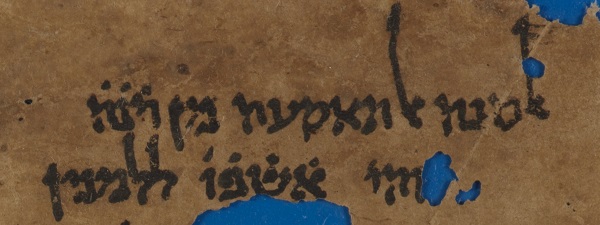
T-S K2.73 recto calendar fragment showing a Seleucid date in the same hand as our skilled scribe
What would be the provenance of this script, in that case? My assessment is that this script is rather distinctive, but has structural similarities with scripts from the Syria-Palestine region, especially the four-stroked alef, downward-facing angle of the serifs, and the high degree of angularity where any two strokes meet. This, as well as the fact that the text has the triennial Palestinian reading order, and the attestation of this same scribe writing a calendar according to the Seleucid dating in Judaeo-Arabic, leads me to conclude that this is likely a highly-calligraphic and stylistic script from the Syria-Levant. The less sophisticated hand helps us here too: we have very close parallels to this hand in some dated texts from late 10th-early 11th c. Damascus, Lebanon, Jerusalem, and Syria (see plates 6, 7, 21, and 23 of Beit-Arie and Engel), which share with our fragment the curved right ‘foot’ of a four-stroked alef, the sweeping downstrokes of tav and ayin, and the long soffit letters.6 Given its setting and its clear comparable peers, it is not unreasonable to say that this hand is from the same region, a (less-skilled) Hebrew script written in a more relaxed, almost ‘mashait’ manner. Whatever is the case, it is certain that this is an Oriental hand in context: as we will discuss below, our less-skilled scribe (in Hebrew) was seemingly more skilled in writing Arabic script.
Navigating the Haftarot: Multilingual Signposting
Throughout our manuscript both scribes write headings to indicate what passage is being read, and when the haftarah begins, although this is sometimes inconsistent. In this aspect we are not so concerned with our sophisticated scribe as our so-called ‘apprentice’. While he frequently includes Hebrew lemmas (when he feels like it) to mark the verse, he also has three noteworthy headings and endings to passages. The first we see on fol. 6 v.: אפטארה, for ‘haftarah (הפטרה)’. The heh is dropped and the a-vowel spelled long. While this could be a simple phonetic spelling of the Hebrew word, a few pages later (fol. 8r), in fluid Arabic script: تمت الافطاره, ‘concludes the haftarah’. The spelling of the Arabic and the Hebrew of ‘haftarah’ are identical. The same note appears again on fols. 9v. and 11v. Given that this scribe is able to write continuous passages from across the Tanakh, vocalise them, provide accurate lemmata and headings, and write in a fluid Arabic script, one must consider the possibility that this ‘apprentice’ was closer to a peer with the more sophisticated of this fragment.

The scribe's Hebrew mis-spelling of Haftarah

T-S 6H5.1 leaf 8 recto showing his Arabic spelling of Haftarah
A Targum is a Targum: Textual Oddities
An integral part of hearing a fragment’s story is getting acquainted with its text. While I do not have the space to include all 14 pages of Targum here, we can satisfy ourselves with a sampling from both our scribes.
‘Apprentice’ (fol. 1r):
Deut. 31:16
Lines 1–2: :דחלתי וישנון קימי [דגזרית] עמהון
Note: 1. the superscript nun in וישנון is a correction (by the same scribe); Note the direct object marker is missing (exp. ית קימי).
Line 2: a liturgical phrase preceding the haftarah appears here but is illegible.
1 Kgs. 2:1–3
Lines 3–4: :וקריבו יומי דויד לממת ופקיד ית שלמה בריה למימר
Lines 5–7: :אנוכי אנא אזיל בארח כל ארעא ותתקף ותהי לגבר דחיל חטאין
Note: Hebrew lemma
Lines 8–14: ושמרו ותטר ית מטרת מימרא דיוי אלהך למהך באורחן דתקנן קדמוהי למטר קימוהי פיקודוהי
:ודינוהי וסהדותיה כמא דכ[תי]ב באוריתא דמשה בדיל דתצלח ית כל די דתעביד וית כל די דתתפני לתמן
Notes: The incorrect spelling of the Hebrew lemma (1 Kgs. 2:3); the instances of ית כל in the bold are attested variants for Targum Jonathan, but note that אתר is missing before דתתפני.
‘Master’ (fol. 6r):
Josh 1:7–9
Lines 1–5: לחוד תקוף ועילם לחדא למעבד ככל אוריתא דפקדך משה עבדי לא תסטי מנהרק חזק ואמץ
:לימינא ולשמאלא בדיל דתצלח בכל אתר די תהך
Notes: This scribe writes three words for the lemma instead of one; writes די separately on the last word (expected suffixed preposition); sin for samek interchange in ולשמאלא.
Lines 5–9: לא ימוש לא יעדי ספרא דאוריתא הדן מפמך ותהי הגי בה ימם ולילי בדיל דתטר למעבד ככל דכתיב
:ביה ארי כען תצלח ית אורחתך ובכן תכשיט
Notes: textual variant: ‘now’ (כען) instead of ‘then’ (בכין)
Lines 9–12: הלא צויתיך הלא פקידתך תקיף ועילם לא תדחל ולא תתבר ארי במעדך מימרא ייי אלהך בכל
:אתר די תהך
Notes: במעדך may be a misspelling (exp. בסעדך)
Both texts are remarkably close to our current extant editions of the Targums, with only slight variations.
Conclusion
This small, humble manuscript made essentially of notepaper tells a fascinating story of scribal collaboration and gives us a window into the functional scribal world of the Genizah. The intended use of such a manuscript was perhaps boringly practical: in it one can find a faithful record of the haftarah readings for the few Shabbats before Pesach, in Aramaic, in close agreement with the texts passed down to modern scholars today. Yet it was made by two people with very different writing skill sets, working closely together, the one more skilled in calligraphy correcting the other, suggesting a possible didactic context. That people would bother to casually note down these passages in Aramaic, with clear headings, strongly suggests that they had a practical use in the context of a synagogue service, if not for liturgical reading, then for study of the haftarah in Aramaic. At the same time, the manuscript is embedded within an Arabic-speaking culture. Perhaps the most interesting aspect of this document is its potential scribal connection with other kinds of documents that are similarly connected to liturgy: calendrical texts. Not only does this manuscript tell us a silent story simply by virtue of its features, but it reinforces what is truly special about the Genizah: that often-mundane texts penned almost 1,000 years ago live on in the scholarly meaning they carry for us today.
Footnotes
1 This research was performed under the remit of the ERC funded project ‘TEXTEVOLVE: A New Approach to the Evolution of Texts Based on the Manuscripts of the Targums’ (grant id. no. 818702).
2 The fragment is presented in Klein’s catalogue, entry 459, pg. 39 (Klein, M., 1992. Targumic manuscripts in the Cambridge Genizah collections (Cambridge University Library. Genizah series ; 8). Cambridge: Cambridge University Press). Studies which comment briefly upon its organisational features of the haftarah passages (specifically the versification and Kalirian liturgical phrases appearing before the haftara passages) include: Staalduine-Sulman, E. (2002). The Targum of Samuel (Studies in the Aramaic interpretation of Scripture; v. 1). Leiden: Brill., pp. 60, 320; Kallir, E., Elizur, E., & Elizur, Shulamit. (1988). Piyuṭe R. Elʻazar Birabi Ḳilar (Sidrat sefarim mi-yisudo shel S. Sh. Peri). Jerusalem: Magnes Press, The Hebrew University, pp. 96-97; Joseph Ofer (1989). The Masoretic Divisions (Sedarim) in the Books of the Prophets and Hagiographa. Tarbiz, vol. 58. Mandel Institute for Jewish Studies, pp. 179, 185-87; Fleischer, E. (2003). Remarks concerning the triennial cycle of the Torah reading in Eretz Israel. Tarbiz 73 (1), p. 100.
3 Cf. Charles Perrot, ‘The Reading of the Bible in the Ancient Synagogue’, esp. p. 141-143, 146-147. In Mulder, Sysling, Mulder, M. J, & Sysling, Harry. (1988). Mikra: Text, Translation, Reading and Interpretation of the Hebrew Bible in the Ancient Judaism and Early Christianity (Compendia rerum Iudaicarum ad Novum Testamentum. Section 2, The literature of the Jewish people in the period of the Second Temple and the Talmud). Assen/Maastricht : Philadelphia: Van Gorcum ; Fortress Press.
4 See the online resource of ‘Calendar Fragments as a Tool for Palaeography’, where the information for shelfmarks T-S K2.73; T-S NS 98.87; T-S AS 71.83 can be viewed under the 1000 CE heading. https://www.lib.cam.ac.uk/collections/departments/taylor-schechter-genizah-research-unit/projects/calendar-fragments-tool
5 Beit-Arié, Hebrew Codicology: Historical and Comparative Typology of Medieval Hebrew Codices based on the Documentation of the Extant Dated Manuscripts until 1540 using a Quantitative Approach. Ed. Nurit Pasternak. Jerusalem 2021, The Israel Academy of Sciences and Humanities, p. 171.
6 Beit-Arié, Engel, Yardeni, Beit-Arié, Malachi, Engel, Edna, Yardeni, Ada, and Comité De Paléographie Hébraïque. Asupot Ketavim ʻIvriyim Mi-Yeme-ha-Benayim. Publications of the Israel Academy of Sciences and Humanities. Yerushalayim: Ha-Aḳademyah Ha-leʼumit Ha-Yiśreʼelit Le-madaʻim, 1987.
Cite this article
Arrant, Estara. 2022. "A Story of Scribal Collaboration: The Targum of T-S 6H5.1." Taylor-Schechter Genizah Research Unit. doi:10.17863/CAM.99641.
If you enjoyed this Fragment of the Month, you can find others here.
Contact us: genizah@lib.cam.ac.uk
The manuscripts in this article are part of the Cairo Genizah Collection in Cambridge University Library. To see more items from this collection visit: https://cudl.lib.cam.ac.uk/
